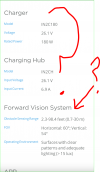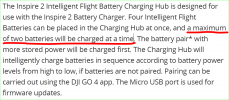Touché. I just hate these conversations where we're talking past one another. It's frustrating.
Correct.
The only way to know if the 12VDC->27VDC device works in concert with the DJI hub is to FULLY UNDERSTAND BOTH devices. And in order for THAT to happen, you would have to post complete specifications for BOTH of these devices - not just links to Amazon.
Glaring questions; What is the input CURRENT and output CURRENT of your Amazon device? Amazon lists a myriad of current (amperage) ratings (which appear to be output current), but how does it achieve these different ratings? How does it LIMIT current to 1A or 2A??? I see NOTHING in that Amazon ad to show this is facilitated.
More questions....
Are these myriad of current ratings at the INPUT side or the OUTPUT side??? The ad suggests that this is the output current, but then input current would be 22.5A, which would melt those wimpy #14-looking wires. They could save all all a bunch of headache by simply listing the WATTAGE ratings, which would be the same at both ends.
But then the ad says this:
View attachment 32682
So now we're back to assuming that the 10A rating is the INPUT current. Or we have to assume that this device somehow magically has transcended Ohm's Law and ergo has an output wattage that is greater than its input wattage. Free electricity!!!
More questions....
Is the DJI hub a serial or parallel device? It's been my experience that DJI PASSIVE hubs are always serial. But who knows??? Since the
Inspire 2 REQUIRES 2 batteries, I would assume that it charges the batteries in parallel. But I'm not sure.
So the only way we could even remotely entertain the possibility that this combination of Amazon device in concert with the DJI hub as a "solution" is if we make a couple assumptions.
Assumption #1; The Amazon device is 10A on the output side. But see above. There are inconsistencies.
Assumption #2; The DJI hub charges the batteries in parallel, not series.
Based on these assumptions, the math looks good! 270 watts / 2 = 135 watts per battery. This would be a respectable charge.
But there's a problem....
270 watts / 12 = 22.5A on the input side. This would require #10 conductor (wire). Looking at the photo, these do NOT look like #10 conductors to me:
View attachment 32677
Truth be told, they don't even look like #12 conductors. They look like #14 to me. But who knows?!?! Right? But again, there's this:
View attachment 32685
#14 wire is rated at 15A, which aligns with my observation AND the required fuse! CONFUSING!!
I hope this explains why I was "wound up." LOTS of blank spaces....LOTS of assumptions....LOTS of missing information. Dare I say even CONFLICTING information in the Amazon ad. Their math is NOT adding up! Dollars to doughnuts they are over-selling the output ratings. I would bet 5 bucks that the output rating is NOT up to 10A. Doing simple Ohm's Law math and assuming an input current limit of 15A, output is going to be closer to 6A-7A with the engine off, and maybe as high as 7.7ish Amps with the engine running.
10A on which end? Input or output? The ad suggests 10A on the output side. If so, then that is max output, which means there is going to be a duty rating. More than likely you can't just run this boost converter 24/7. More than likely it will have a duty rating that may be as low as 50%....and probably not any higher than 80%.
And there still exists that pesky, looming question; How does this device LIMIT current to 1A or 2A or 3A at the output side???
Correct.
Okay....so the charger IS a parallel charger, yes???
Your math is sound. But you are assuming that 10A is the output current, which would put input current around 22.5A. If this is true, I would be very concerned with those conductors (wires). The input wires should be #10 or better. But they tell you to install a 15A fuse on the input side. Confusing. Conflicting.
True.
I just got frustrated. I apologize.
I am not familiar with the
Inspire 2 at all, which was one of the sources of frustration. That's why I wanted specifications on all the devices you suggested.
According to DJI, this is a parallel/serial device:
View attachment 32681
So while this kind of looks good on paper, there are a couple of problems (as I have indicated above). If you are going to try this, my strong suggestion would be to monitor the temperature of those input wires. I would also monitor charge times. Mathematically, some things are just not adding up.
D













